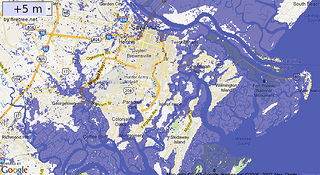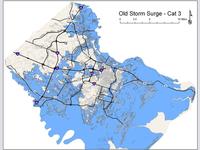Savannah and Jacksonville are among the east coast cities most vulnerable to rising sea levels due to climate change, a study finds. Savannah, Georgia’s main seaport, with storm surges, hurricanes, and waves on top: what will that look like?
Suzanne Goldenberg wrote for the Guardian today, US coastal cities in danger as sea levels rise faster than expected, study warns: Satellite measurements show flooding from storms like Sandy will put low-lying population centres at risk sooner than projected,
A study published last March by Climate Central found sea-level rise due to global warming had already doubled the risk of extreme flood events — so-called once in a century floods — for dozens of locations up and down the Atlantic and Pacific coasts.
It singled out the California cities of Los Angeles and San Diego on the Pacific coast and Jacksonville, Florida, and Savannah, Georgia, on the Atlantic, as the most vulnerable to historic flooding due to sea-level rise.
Sandy, which produced a 9ft storm surge at Battery Park in New York City, produced one example of the dangerous combination of storm surges and rising sea level. In New York, each additional foot of water puts up to 100,000 additional people at risk, according to a map published with the study.
That study projected 6 inches rise at Fort Pulaski by 2030 (minimum 3 inches) and 13 inches by 2050 (maximum 24 inches). But projections have gotten worse since then:
The latest research, published on Wednesday in Environmental Research Letters, found global sea-levels rising at a rate of 3.2mm a year, compared to the best estimates by the IPCC of 2mm a year, or 60% faster.
So that would be more like 9 inches by 2030 and 20 inches by 2050.
Add to a higher base sea level bigger storms like Hurricane Sandy, and Savannah and Jacksonville have a problem. Sure, Savannah is nominally somewhere around 40 to 49 feet above sea level, but parts of Manhattan are much higher than that. And parts of both are lower. According to the Climate Central fact sheet for Georgia:
- Odds of a 100-year flood or worse by 2030, with sea level rise from global warming: 83%
- Odds without global warming: 0%
- Bottom line: global warming multiplies the odds by >3X
- Historic local sea level rise rate: 1.2 inches/decade
- Projected new sea level rise by 2050: 13 inches
 Remember, that was before the new research that says sea levels
are actually rising 60% faster.
Plus a very high likelihood of at least one Sandy-class storm.
Lower Manhattan had
an almost 14 foot storm surge.
That’s close to 3 meters sea level rise,
which at Savannah would look like
the map on the right.
Remember, that was before the new research that says sea levels
are actually rising 60% faster.
Plus a very high likelihood of at least one Sandy-class storm.
Lower Manhattan had
an almost 14 foot storm surge.
That’s close to 3 meters sea level rise,
which at Savannah would look like
the map on the right.
But wait: that doesn’t take into account two other factors:
the local rivers.
Last year the
Chatham Emergency Management Agency (CEMA)
unveiled some maps of what would really be likely to happen,
according to
Sheila Parker in WSAV 20 June 2011,
New Storm Surge Maps For Chatham County Unveiled During EOC Briefing.

 On the left is the “Old” Category 3 Storm Surge Map,
which looks much like the 5 meter map above, except maybe already worse.
(Tybee Island is completely underwater even in a Category 1 hurricane,
according to CEMA’s maps.)
On the right is the “New” Category 3 Storm Surge Map,
and here’s a description from CEMA Director Clayton Scott,
On the left is the “Old” Category 3 Storm Surge Map,
which looks much like the 5 meter map above, except maybe already worse.
(Tybee Island is completely underwater even in a Category 1 hurricane,
according to CEMA’s maps.)
On the right is the “New” Category 3 Storm Surge Map,
and here’s a description from CEMA Director Clayton Scott,
“The city of Savannah essentially becomes an island in about a category 2 storm—it’s what had been a category 3 storm before is now occurring at a category 2 storm.” To illustrate just how much more of the area is predicted to be under water. The pictures with this article show the “old” storm surge map for a Category 3 hurricane…with the areas in light blue what would be expected to be under 17 to 23 feet of water…and the new map—which takes into account what would happen when the Savannah and Ogeechee rivers overflow during the storm surge and that water is pushed inland.
Scott says the Director of the National Hurricane Center calls this the worst storm surge area on the entire east coast of the United States, “The point is, if it does hit us—the storm surge is gonna be unbelievable in Chatham county and to me a prudent person would say I don’t want to risk my life and my family’s life—I’m gonna get out of town.” Scott says the reason storm surge here is expected to be so bad is that our coastline is so shallow for about 90 miles out to the Gulf Stream. He says there’s just no other place for the water to go.
 Category 3, as in Hurricane Katrina when it hit New Orleans.
In 1999, Hurricane Floyd missed Tybee Island by 119 miles,
and was a Category 4 storm at the time.
What Savannah would like like in a Category 4 hurricane is shown
in CEMA’s map on the left here.
That’s a 23 to 26 foot storm surge.
Category 3, as in Hurricane Katrina when it hit New Orleans.
In 1999, Hurricane Floyd missed Tybee Island by 119 miles,
and was a Category 4 storm at the time.
What Savannah would like like in a Category 4 hurricane is shown
in CEMA’s map on the left here.
That’s a 23 to 26 foot storm surge.
 CEMA’s
Cat 5 map is on the right here.
It doesn’t look much worse, because not much more land would be submerged,
but everything would be about 3 to 5 feet deeper, 26 to 31.5 feet.
CEMA’s
Cat 5 map is on the right here.
It doesn’t look much worse, because not much more land would be submerged,
but everything would be about 3 to 5 feet deeper, 26 to 31.5 feet.
All plus waves on top of the storm surge. And that’s even before further sea level rise.
-jsq
Short Link:
In this context, please note the following note in regard to a recent UN climate report:
http://www.cbsnews.com/8301-205_162-57556153/arctic-sea-ice-larger-than-u.s-melted-this-year/
Michael G. Noll, President
Wiregrass Activists for Clean Energy